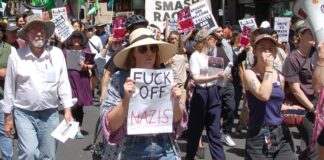On 12 August white supremacist James Fields ploughed his car into counter-protesters in Charlottesville, killing 32-year-old anti-fascist activist Heather Heyer and injuring at least 19 others.
This was the shocking end result of the most significant mobilisation of the US far right in recent memory.
White supremacists, members of the Ku Klux Klan, neo-Nazis and other far right organisations had gathered for a “Unite the Right rally” to protest the removal of a statue of Confederate general Robert E. Lee. The civil war general married into one of the richest slave-owning families in Virginia and was known for his staff brutally beating recaptured slaves.
The day before, the right descended on the University of Virginia campus carrying KKK-like torches and chanting “blood and soil” (echoing the Nazi slogan “blut und boden”), “white lives matter” and “Jews will not replace us.” Formerly relegated to the margins of American society, Donald Trump’s election has encouraged these racists out into the open.
Trump at first would only condemn violence “on many sides”—knowing full well that the only people who committed murder in Charlottesville were from the right. Under pressure two days later he made a mechanical announcement stating “racism is evil.” The following day Trump went back to endorsing the far right, claiming, “you had people that were very fine people on both sides… Not all those people were neo-Nazis, not all those people were white supremacists”.
Trump’s response provoked widespread outrage. Even prominent Republicans condemned his comments. Business leaders joined the chorus—the CEOs of Merck Pharmaceuticals, tech company Intel, clothing giant Under Armour, and multinational conglomerate 3M, all resigned from Trump’s manufacturing council. The Strategic Policy Forum, representing some key players in the capitalist class, disbanded. CNN reportedly struggled to find anyone willing to go on air to defend Trump.
Trump’s flirtations with fascists didn’t begin with Charlottesville. His recently departed chief strategist Steve Bannon is well-known for his white supremacist views as editor of far-right news site Breitbart. At Trump’s Inaugural Ball, White House deputy assistant Sebastian Gorka wore the medal of a Hungarian organisation that collaborated with the Nazis during World War II, and still holds strong connections to vicious anti-Muslim and anti-immigrant organisations in Hungary.
Both Bannon and Gorka were strong supporters of Trump’s protectionist “America first” foreign policy and trade agenda. While both have now been removed from their White House posts, they will return to Breitbart. In his departure letter, Gorka wrote, “the best and most effective way I can support you, Mr. President, is from outside the People’s House.”
United response
In the aftermath of Charlottesville, the far right’s attempt to go on the offensive was met with overwhelming resistance from ordinary people.
In Boston more than 20,000 people marched against the right’s 15-person “free speech” demonstration on 19 August. Since then the right has been forced to cancel 67 rallies across 36 states.
In northern California’s Bay Area more than a hundred organisations, including the Berkeley Federation of Teachers, branches of the unions representing service workers and public sector employees, Black Lives Matter, Muslim Students Associations, the International Socialist Organization and the Democratic Socialists of America, came together to protest the right on 26 and 27 August. In the face of such a united front, the right cancelled both its rallies in Berkeley and San Francisco.
This kind of broad left response, grassroots organising, and mass mobilisations are key for resisting the right on the streets and Trump in the White House.
There is an important debate about how to take on the right. Some organisations like the Southern Poverty Law Center, which documents hate crimes in the US, argue that we shouldn’t mobilise against the right as it only gives them the publicity they crave. But this only allows them to march unopposed, and spread their ideas without challenge. Others in the movement call for “black bloc” tactics, where small groups of masked militants fight Nazis and the police. But this elitist strategy cannot mobilise the kind of numbers needed to confront and isolate the right.
Our best weapon is huge, mass protests to send these Nazis back into the sewers they crawled out of. And to link the fight against the far right to fighting the Trump administration and the racism around deportations and his Muslim travel ban, that has encouraged them.
What’s more, we need a political vision that looks beyond the straightjacket of mainstream politics. US politicians have spent 40 years lurching to the right. Democrats and Republicans alike have done nothing about racist police; both parties have used anti-immigrant racism and Islamophobia to ram through austerity and war. We need a socialist alternative to the spineless Democratic Party that long ago abandoned working people, women, and people of colour.
By Sofia Donnelly





